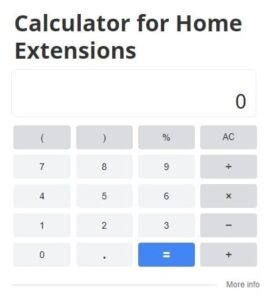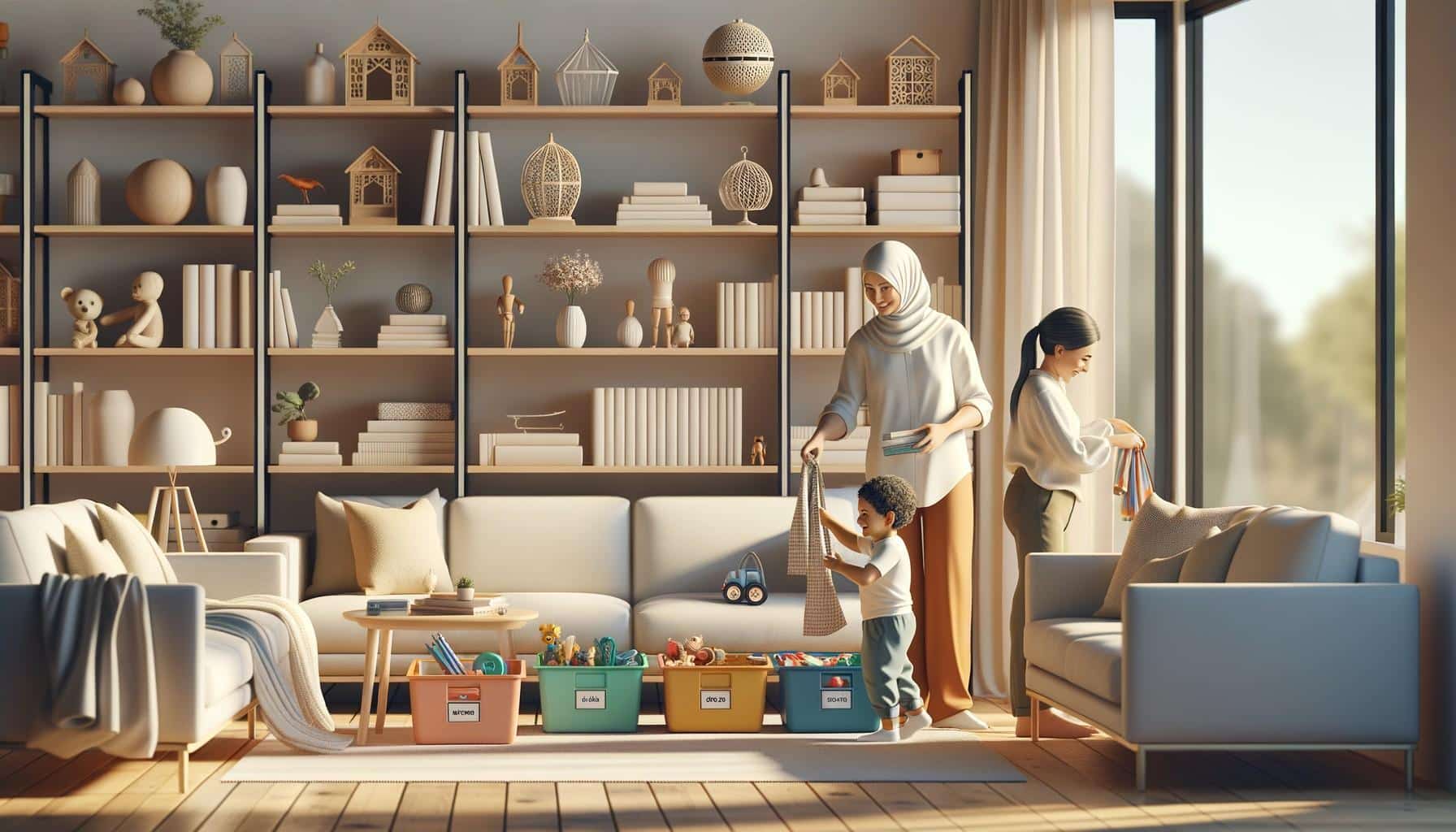
A cluttered home creates stress and wastes precious time searching for misplaced items. The average American spends 12 minutes daily looking for lost belongings, according to a UCLA study.
We at Home Owners Association believe effective organisational tips for home management transform chaotic spaces into functional havens. The right systems make maintaining order effortless rather than overwhelming.
Which Decluttering Method Gets Results Fast
Start with the 90/90 rule when you face overwhelming clutter. If you haven’t used an item in 90 days and can’t imagine use for it in the next 90 days, donate or discard it immediately. This rule eliminates significant household clutter by focusing on actual usage patterns rather than emotional attachments or hypothetical future needs.
Focus on High-Impact Areas First
Begin decluttering in your bedroom and kitchen since these spaces directly affect daily function. Clear bedroom surfaces first to create immediate visual calm, then tackle kitchen counters where clutter accumulates fastest. Professional organisers report that clients who start with these areas maintain momentum better than those who begin with storage rooms or basements. Organised bedrooms improve sleep quality for most clients within two weeks.
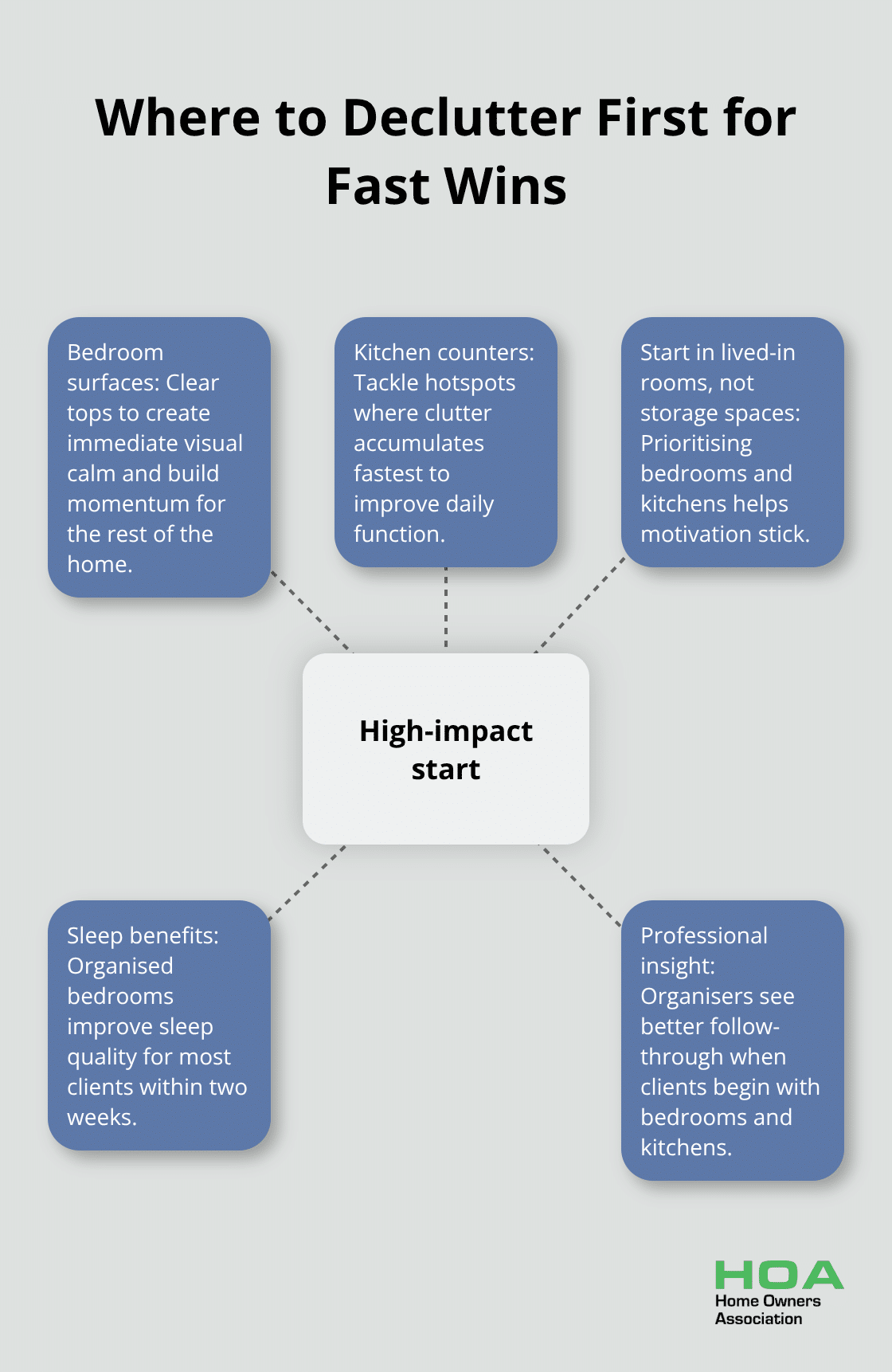
Create Three Decision Categories
Sort items into keep, donate, and discard piles with specific criteria. Keep items you’ve used within six months and genuinely need. Donate anything in good condition that doesn’t serve your current lifestyle. Discard broken items, expired products, and anything unsafe or unsanitary. Americans discard 82 pounds of textile waste per year, yet most people struggle with donation decisions.
Set Time Limits to Prevent Overwhelm
Set a timer for 15 minutes per room to prevent decision fatigue and maintain progress. This time limit forces quick choices and prevents overthinking that leads to keeping unnecessary items. The constraint creates urgency that bypasses emotional attachment to objects. Professional organisers use this technique because it produces faster results than open-ended sessions (which often result in reorganisation rather than actual decluttering).
Once you complete the initial decluttering phase, you’ll need smart storage solutions to maintain your newly organised spaces and maximise every square foot of your home.
Smart Storage Solutions for Every Room
Wall-mounted shelves and ceiling-high cabinets transform wasted vertical space into functional storage areas. Install floating shelves 18 inches apart to accommodate most household items while you maintain visual appeal. Vertical storage solutions can significantly enhance storage capacity in standard rooms. Mount hooks on walls and inside cabinet doors to hang frequently used items like keys, towels, and cleaning supplies. Ceiling-mounted racks work perfectly for seasonal items and sporting equipment that you access occasionally.
Multi-Purpose Furniture That Maximises Space
Ottoman storage benches provide seats while they hide blankets, games, and seasonal clothes. Coffee tables with built-in drawers replace traditional tables and eliminate the need for separate storage furniture. Bed frames with integrated drawers maximise bedroom storage without they require additional floor space. Storage headboards hold books, electronics, and personal items within arm’s reach. These multi-purpose pieces offer space and cost advantages compared to separate furniture and storage units.
Budget-Friendly Organisation Tools Under $50
Drawer dividers keep small items separated and findable for under $15 per drawer. Clear stackable bins with labels work better than opaque containers because you see contents immediately. Tension rods create instant shelf dividers in cabinets and prevent items from toppling over. Over-the-door shoe organisers hold cleaning supplies, toiletries, and craft materials beyond just footwear.
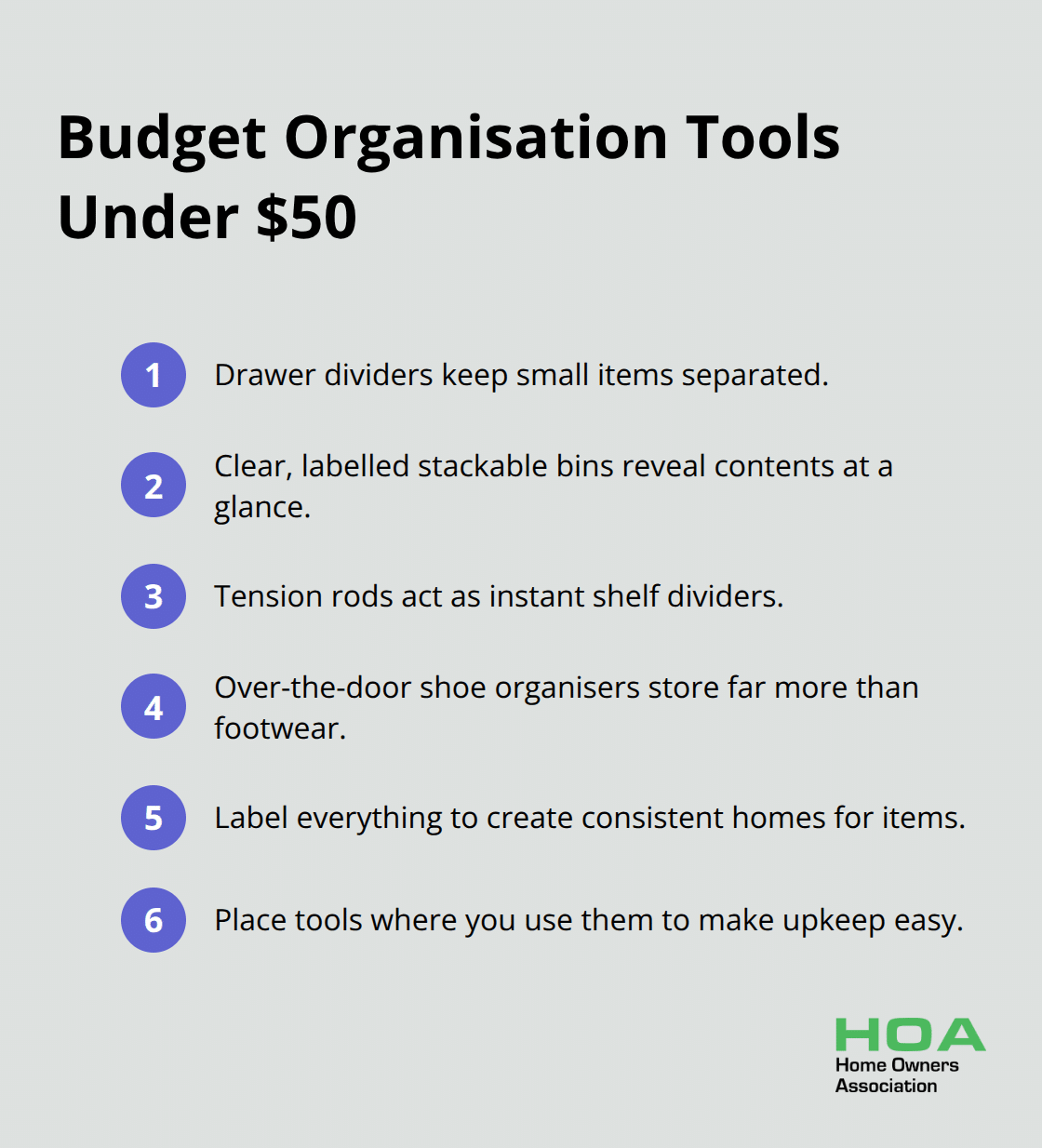
These simple tools prevent the clutter creep that happens when items lack designated homes (which affects 73% of households according to recent organisation studies).
Custom Storage for Problem Areas
Kitchen pantries benefit from tiered shelf inserts that double storage capacity for canned goods and spices. Bathroom medicine cabinets work better with magnetic strips that hold small metal items like tweezers and nail clippers. Closet rod doublers create two hanging levels where you previously had one. Under-bed storage boxes hold seasonal items and maintain clean lines, with Sterilite containers costing $15-25 and fitting standard bed heights. These targeted solutions address specific storage challenges that generic organisers cannot solve.
Smart storage systems only work when your family maintains them consistently, which requires establishing daily and weekly routines that keep clutter from returning.
How Do You Maintain Organisation Long-Term
The 15-Minute Reset That Prevents Chaos
Set a timer for exactly 15 minutes each evening and tackle visible clutter throughout your home. Walk through each room and return items to their designated storage spots. Focus on surfaces like counters, tables, and floors where clutter accumulate fastest. The American Time Use Survey tracks household activities and maintenance routines, showing that consistent daily tidying helps maintain organised spaces.
This brief routine prevents the accumulation of clutter that turns into overwhelming weekend projects. Professional organisers report that clients who commit to this daily practice maintain their organised spaces for over two years. Those who skip daily maintenance typically see clutter return within six weeks, making the evening reset essential for long-term success.
Weekly Deep Organisation Sessions
Schedule specific organisation tasks for weekends when you have more time and energy available. Saturdays work best for 30-minute deep organisation sessions in one room. Sundays suit planning and preparation for the upcoming week better than other days.
Focus on one area per week rather than attempting multiple rooms simultaneously. Tackle closets one week, kitchen cabinets the next, then bathroom storage areas. This systematic approach prevents overwhelm while maintaining steady progress throughout your home.
Monthly Maintenance Tasks That Lock In Results
Monthly tasks include rotation of seasonal items, purging of expired products, and reassessment of storage systems that no longer function effectively. Time management research shows that households with scheduled maintenance routines save significant time, with many reporting over an hour saved per day through organised systems.
Check expiration dates on medications, cosmetics, and pantry items during the first weekend of each month. Replace broken storage containers and update labels that have become unclear or damaged. These monthly check-ins catch problems before they become major organisational setbacks.
Family Systems That Actually Stick
Assign each family member one weekly task like organising their bedroom or maintaining a specific storage area. Children over age seven can handle simple tasks like sorting their toys or keeping their backpacks organised. Teenagers manage their own closets and study areas completely without parental supervision.
Create accountability through visual tracking systems that show each person’s organisation responsibilities clearly. Place a simple chart in a common area where family members check off completed tasks. This makes progress visible and encourages consistency across all household members.
Final Thoughts
Successful home organisation demands commitment to proven systems rather than perfect execution. The 90/90 rule eliminates decision paralysis while room-by-room decluttering creates manageable progress. Vertical storage solutions and multi-purpose furniture maximise space without excessive costs.
Daily 15-minute resets prevent clutter accumulation more effectively than weekend marathon sessions. Weekly deep organisation and monthly maintenance tasks secure long-term results. Family accountability systems distribute responsibility and establish lasting habits that stick (with 73% of households reporting improved organisation when all members participate).
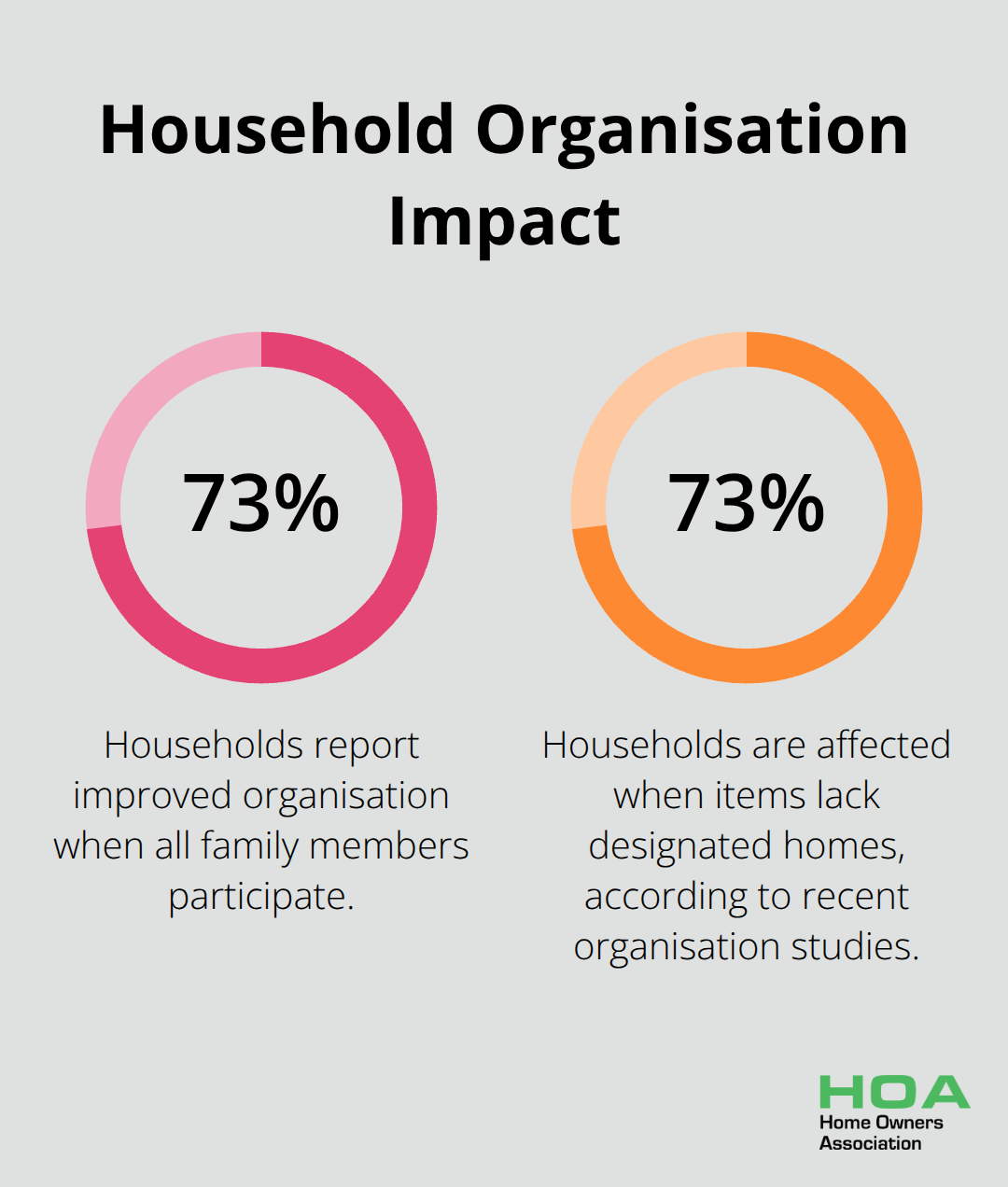
The most effective organisational tips for home management focus on consistency over perfection. Start with high-impact areas like bedrooms and kitchens, then expand systematically through your space. We at Home Owners Association support Melbourne homeowners with quality renovation materials and expert guidance, helping you create organised spaces that function beautifully for years to come.





